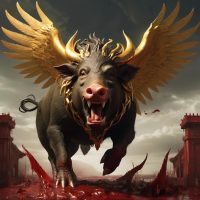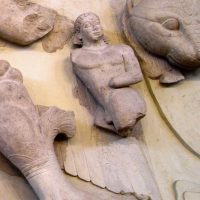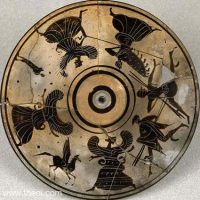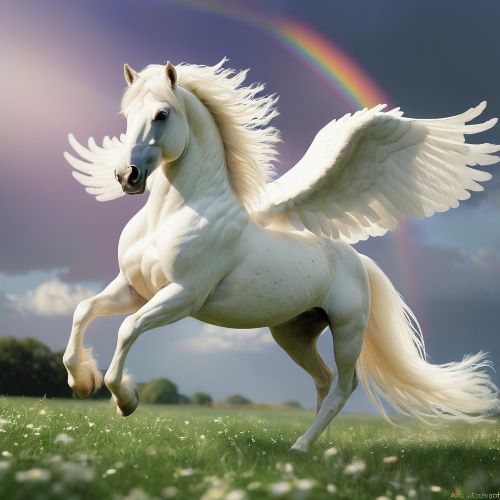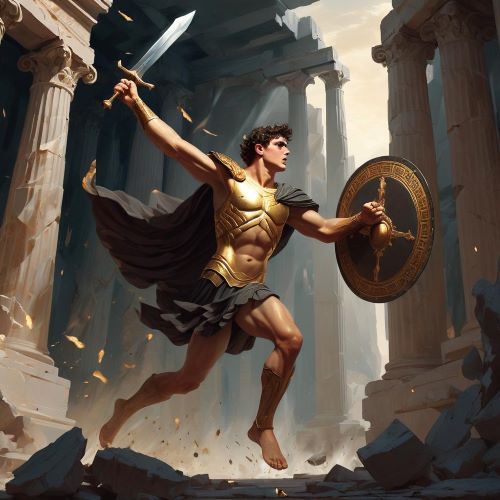Chrysaor : The Golden Warrior
Listen
At a glance
| Description | |
|---|---|
| Origin | Greek Mythology |
| Classification | Gods |
| Family Members | Poseidon (Father), Medusa (Mother), Pegasus (Sibling), Callirrhoe (Wife), Geryon (Child) |
| Region | Greece |
| Associated With | Battle, Sword |
Chrysaor
Introduction
Chrysaor, whose name in Ancient Greek (Χρυσάωρ) means “Golden Sword,” is one of the more enigmatic figures of Greek mythology. His birth is among the most dramatic in myth, occurring when Perseus beheaded Medusa, the mortal Gorgon. From the blood that spilled onto the earth, two beings emerged: Pegasus, the winged horse destined for glory, and Chrysaor, a figure associated with strength, power, and sometimes mystery. Unlike Pegasus, who became a celebrated companion of heroes, Chrysaor occupies a more shadowed place in myth. Some traditions describe him as a giant or warrior wielding a gleaming golden blade, while others depict him in a zoomorphic form, even as a winged boar. This duality makes him a fascinating character, embodying themes of martial force, divine lineage, and symbolic transformation.
Physical Traits
Chrysaor’s appearance is not fixed, reflecting the fluid nature of myth across regions and time periods. In Hesiod’s Theogony, he is not elaborately described but is suggested to be a youthful figure of great strength, aligned with the martial symbolism of his name. Later traditions often imagine him as a giant, towering and formidable, equipped with golden armor and a radiant sword that embodies divine authority. This interpretation underscores his role as a warrior and a representation of battle power inherited from Poseidon.
Other depictions, particularly in ancient art and later interpretations, present Chrysaor in a far stranger guise. Some sources suggest that he was visualized as a winged boar, a creature symbolic of ferocity and destruction. This contrasts sharply with Pegasus, his graceful, heroic twin, and highlights Chrysaor’s darker, wilder attributes. The image of the winged boar also carried connotations of divine wrath and uncontrollable force, making him a symbol of raw destructive power. Between these versions—giant, warrior, and beast—Chrysaor emerges as a liminal figure who straddles the boundary between human heroism and monstrous ferocity.
Family
Chrysaor’s lineage places him at the center of several important mythological lineages. He was the son of Medusa, once a beautiful mortal who was transformed into a Gorgon by Athena after being violated by Poseidon. Poseidon, god of the sea and earthquakes, is therefore Chrysaor’s father, making him the child of a union between divinity and mortal tragedy. His simultaneous birth with Pegasus reinforces the dual nature of Medusa’s legacy: one child embodying nobility and heroism, the other embodying raw strength and martial dominance.
Chrysaor later married Callirrhoe, an Oceanid and daughter of Oceanus, the Titan of the great river encircling the world. Their most famous child was Geryon, the three-bodied giant who was ultimately slain by Heracles during his tenth labor. Some genealogies also attribute Echidna, the half-woman, half-serpent monster, as his daughter, though this is debated among scholars. These descendants extend Chrysaor’s influence into some of the most formidable and monstrous figures in Greek mythology, cementing his role as a progenitor of beings who challenged heroes and embodied the chaos of the mythic world.
Other names
The name Chrysaor is sometimes rendered in alternate forms such as Khrysaor or Khrysaoros due to transliteration from Greek. The literal translation, “Golden Sword,” is less a name than a descriptive epithet, reflecting either a literal weapon or a metaphor for divine strength and martial authority. Hesiod explains the epithet as arising because Chrysaor carried a golden blade. Interestingly, similar names appear in agricultural contexts, such as Demeter being called “Khrysaoros,” meaning “of the golden blade of wheat.” This suggests that Chrysaor’s name may also have chthonic or fertility associations in certain cultic traditions, blending images of death, harvest, and rebirth.
In modern contexts, the name Chrysaor has been adapted in astronomy and biology, such as its proposal as the name of an extrasolar planet and its link to the butterfly genus Chrysoritis. These adaptations highlight how mythological figures continue to inspire symbolic naming even today.
Powers and Abilities
Although ancient sources provide little detail about Chrysaor’s specific exploits, his mythic attributes suggest formidable power. As the embodiment of the “Golden Sword,” he personifies martial brilliance, divine precision, and deadly force. His golden weapon symbolized not only physical strength but also the authority granted by his divine parentage.
In versions where he takes the form of a winged boar, Chrysaor represents unrestrained ferocity, capable of charging through enemies with unstoppable force. Boars were often associated in Greek culture with untamed wilderness and divine punishment, making this form a striking symbol of chaotic but sacred power.
Through his descendants, particularly Geryon, Chrysaor’s legacy is tied to extraordinary strength, monstrous endurance, and challenges that only the mightiest heroes could overcome. His genealogy makes him an ancestor of beings who tested the resolve of figures like Heracles, which extends Chrysaor’s influence across the heroic age of Greek myth.
Modern Day Influence
Unlike Pegasus, whose image became iconic in art, literature, and modern branding, Chrysaor’s presence in popular culture has been more subtle yet significant. Writers and artists exploring the darker or more obscure corners of Greek mythology have revived his story, emphasizing his ambiguous forms and symbolic resonance.
Chrysaor appears in Rick Riordan’s Heroes of Olympus series, where he is portrayed as a formidable antagonist, reminding readers that Greek mythology is filled with overlooked figures who still carry narrative weight. In role-playing games, novels, and fantasy literature, Chrysaor often emerges as a symbol of hidden power, destructive potential, or the untold stories lurking beneath well-known myths.
Academics also take interest in Chrysaor, especially as an example of mythological ambiguity. His dual depictions as both warrior and beast offer insight into how myths adapt across cultures and regions, reflecting the interplay of human imagination, symbolism, and storytelling traditions.
In modern symbolic usage, Chrysaor can represent the shadow side of divine inheritance—the power that is awe-inspiring but potentially destructive if not tempered. His name has been used for contemporary projects, companies, and even proposed celestial bodies, illustrating his continued relevance as a figure of mythic imagination.
Related Images
Source
Britannica Contributors. (2025, August 27). Pegasus | Winged Horse, Bellerophon, Chrysaor. Britannica. https://www.britannica.com/topic/Pegasus-Greek-mythology
Comunale, J. (1999). Chrysaor in Greek Mythology | Overview & Alternative Names. Study.com. https://study.com/academy/lesson/chrysaor-overview-facts.html
Greek Gods and Goddesses. (2023, April 5). Chrysaor. Greek Gods and Goddesses. https://greekgodsandgoddesses.net/myths/chrysaor/
Greek Legends and Myths. (2019, November 10). Chrysaor in Greek Mythology. https://www.greeklegendsandmyths.com/chrysaor.html
Hyginus, P. (Translated by Grant). (2nd century AD). Fabulae. Theoi Greek Mythology. https://www.theoi.com/Ther/Khrysaor.html
Mythlok.com. (n.d.). Chrysaor: The Golden Blade. Mythlok. https://mythlok.com/chrysaor/
Wikipedia contributors. (2002, August 31). Chrysaor. Wikipedia. https://en.wikipedia.org/wiki/Chrysaor
Public Domain Super Heroes – Fandom. (2007, December 31). Chrysaor. https://pdsh.fandom.com/wiki/Chrysaor
Frequently Asked Questions
What is lorem Ipsum?
I am text block. Click edit button to change this text. Lorem ipsum dolor sit amet, consectetur adipiscing elit. Ut elit tellus, luctus nec ullamcorper mattis, pulvinar dapibus leo.
What is lorem Ipsum?
I am text block. Click edit button to change this text. Lorem ipsum dolor sit amet, consectetur adipiscing elit. Ut elit tellus, luctus nec ullamcorper mattis, pulvinar dapibus leo.
What is lorem Ipsum?
I am text block. Click edit button to change this text. Lorem ipsum dolor sit amet, consectetur adipiscing elit. Ut elit tellus, luctus nec ullamcorper mattis, pulvinar dapibus leo.
What is lorem Ipsum?
I am text block. Click edit button to change this text. Lorem ipsum dolor sit amet, consectetur adipiscing elit. Ut elit tellus, luctus nec ullamcorper mattis, pulvinar dapibus leo.
What is lorem Ipsum?
I am text block. Click edit button to change this text. Lorem ipsum dolor sit amet, consectetur adipiscing elit. Ut elit tellus, luctus nec ullamcorper mattis, pulvinar dapibus leo.


